Description
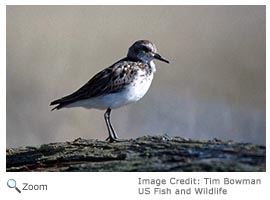 The semipalmated sandpiper is a small shore bird between 5-6 inches in length. It is gray and brown on its uppersides. it has a thin, white wing stripe and a white belly. It has a pointed black bill and black legs. The semipalmated sandpiper is a small shore bird between 5-6 inches in length. It is gray and brown on its uppersides. it has a thin, white wing stripe and a white belly. It has a pointed black bill and black legs.
Semipalmated means half-webbed. The semipalmated sandpiper's toes are actually only slightly webbed, just enough to help them walk on the mud without sinking! Males and females look alike.
Range 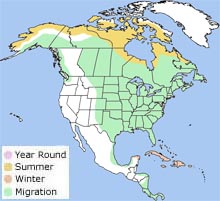 The semipalmated sandpiper breeds in northern Alaska and Canada south to the Hudson Bay. It migrates through the eastern and central states and winters in South America and the Caribbean. The semipalmated sandpiper breeds in northern Alaska and Canada south to the Hudson Bay. It migrates through the eastern and central states and winters in South America and the Caribbean.
|
|
Habitat 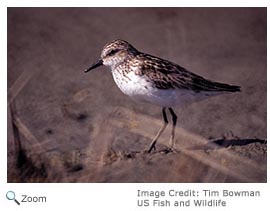 The semipalmated sandpiper breeds on the tundra. It winters on and migrates along coastal beaches, lake and river shores, mudflats, and salt marshes. The semipalmated sandpiper breeds on the tundra. It winters on and migrates along coastal beaches, lake and river shores, mudflats, and salt marshes.
DietThe semipalmated sandpiper eats seeds and aquatic invertebrates.
Life Cycle 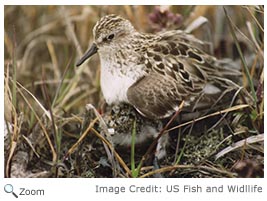 Males arrive on the arctic breeding grounds in late May, usually a few days before the females. The males establish a territory and then try to attract a mate with aerial displays that include hovering in the air and calling out with sharp cries. When it finds a mate, the male creates scrapes or shallow depressions in the ground. The female selects one of the scrapes the male has made and lays four eggs at a rate of one egg a day. Both the male and the female incubate the eggs. Males arrive on the arctic breeding grounds in late May, usually a few days before the females. The males establish a territory and then try to attract a mate with aerial displays that include hovering in the air and calling out with sharp cries. When it finds a mate, the male creates scrapes or shallow depressions in the ground. The female selects one of the scrapes the male has made and lays four eggs at a rate of one egg a day. Both the male and the female incubate the eggs.
The chicks hatch in about 19 days. The chicks are precocial and hunt for insects shortly after birth. They begin to fly when they are about 14 days old. The female usually leaves the chicks about 10 days after they hatch. The male continues to care for the young until they fully fledge at about 19 days.
BehaviorDuring migration, thousands of semipalmated sandpipers can gather to rest and feed on shores.
|

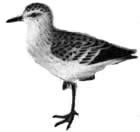

 The semipalmated sandpiper breeds in northern Alaska and Canada south to the Hudson Bay. It migrates through the eastern and central states and winters in South America and the Caribbean.
The semipalmated sandpiper breeds in northern Alaska and Canada south to the Hudson Bay. It migrates through the eastern and central states and winters in South America and the Caribbean.
